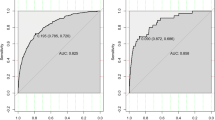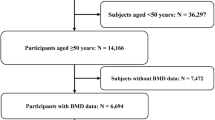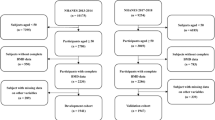Abstract
Currently, dual-energy X-ray absorptiometry (DXA) is the gold standard for detecting osteoporosis, but is not recommended for general population screening. Therefore, this study aims to develop an osteoporosis risk-assessment model to identify high-risk individuals among Korean postmenopausal women. Data from 1,209 and 1,046 postmenopausal women who participated in the 2009 and 2010 Korean National Health and Nutrition Examination Survey, respectively, were used for development and validation of an osteoporosis risk-assessment model. Osteoporosis was defined as T score less than or equal to −2.5 at either the femoral neck or lumbar spine. Performance of the candidate models and the Osteoporosis Self assessment Tool for Asians (OSTA) were compared with respect to sensitivity, specificity, and area under the receiver operating characteristics curve (AUC). To compare the developed Korean Osteoporosis Risk-Assessment Model (KORAM) with OSTA, a net reclassification improvement was further calculated. In the development dataset, the prevalence of osteoporosis was 33.9 %. KORAM, consisting of age, weight, and hormone therapy, had a sensitivity of 91.2 %, a specificity of 50.6 %, and an AUC of 0.709 with a specific cut-off score of −9. Comparable results were shown in the validation dataset: sensitivity 84.8 %, specificity 51.6 %, and AUC 0.682. Additionally, risk categorization with KORAM showed improved reclassification over that of OSTA from 7.4 to 41.7 %. KORAM can be easily used as a pre-screening tool to identify candidates for DXA tests. Further studies investigating cost-effectiveness and replicability in other datasets are required to establish the clinical utility of KORAM.
Similar content being viewed by others
References
World Health Organization (2003) Prevention and management of osteoporosis. WHO Press, Switzerland
Ström O, Borgström F, Kanis JA, Compston J, Cooper C, McCloskey EV, Jönsson B (2011) Osteoporosis: burden, health care provision and opportunities in the EU: a report prepared in collaboration with the International Osteoporosis Foundation (IOF) and the European Federation of Pharmaceutical Industry Associations (EFPIA). Arch Osteoporos 6:59–155
Dawson-Hughes B, Looker AC, Tosteson AN, Johansson H, Kanis JA, Melton LJ 3rd (2012) The potential impact of the National Osteoporosis Foundation guidance on treatment eligibility in the USA: an update in NHANES 2005–2008. Osteoporos Int 23:811–820
Ministry of Health and Social Welfare and Korea Centers for Disease Control & Prevention (2010) Korea Health Statistics 2009: Korean National Health and Nutrition Examination Survey (KNHANES IV-3). Republic of Korea, Osong
Choi HJ, Shin CS, Ha YC, Jang SM, Jang SH, Park CM, Yoon HK, Lee SS (2012) Burden of osteoporosis in adults in Korea: a national health insurance database study. J Bone Miner Metab 30:54–58
Krieg MA, Barkmann R, Gonnelli S et al (2008) Quantitative ultrasound in the management of osteoporosis: the 2007 ISCD Official Positions. J Clin Densitom 11:163–187
Nelson HD, Haney EM, Dana T, Bougatsos C, Chou R (2010) Screening for osteoporosis: an update for the U.S. Preventive Services Task Force. Ann Intern Med 153:99–111
Lim LS, Hoeksema LJ, Sherin K (2009) Screening for osteoporosis in the adult U.S. population: ACPM position statement on preventive practice. Am J Prev Med 36:366–375
Michaëlsson K, Bergstrm R, Mallmin H, Holmberg L, Wolk A, Ljunghall S (1996) Screening for osteopenia and osteoporosis: selection by body composition. Osteoporos Int 6:120–126
Lydick E, Cook K, Turpin J, Melton M, Stine R, Byrnes C (1998) Development and validation of a simple questionnaire to facilitate identification of women likely to have low bone density. Am J Manag Care 4:37–48
Cadarette SM, Jaglal SB, Kreiger N, McIsaac WJ, Darlington GA, Tu JV (2000) Development and validation of the Osteoporosis Risk Assessment Instrument to facilitate selection of women for bone densitometry. CMAJ 162:1289–1294
Sedrine WB, Chevallier T, Zegels B, Kvasz A, Micheletti MC, Gelas B, Reginster JY (2002) Development and assessment of the Osteoporosis Index of Risk (OSIRIS) to facilitate selection of women for bone densitometry. Gynecol Endocrinol 16:245–250
Salaffi F, Silveri F, Stancati A, GrassiW (2005) Development and validation of the osteoporosis prescreening risk assessment (OPERA) tool to facilitate identification of women likely to have low bone density. Clin Rheumatol 24:203–211
Richy F, Deceulaer F, Ethgen O, Bruyère O, Reginster JY (2004) Development and validation of the ORACLE score to predict risk of osteoporosis. Mayo Clin Proc 79:1402–1408
Black DM, Palermo L, Pearson J, Abbott T, Johnell O (1998) SOFSURF: A simple, useful risk factor system can identify the large majority of women with osteoporosis. Bone 23:S605 [abstract]
Weinstein L, Ullery B (2000) Identification of at-risk women for osteoporosis screening. Am J Obstet Gynecol 183:547–549
Koh LK, Sedrine WB, Torralba TP, Kung A, Fujiwara S, Chan SP, Huang QR, Rajatanavin R, Tsai KS, Park HM, Reginster JY; Osteoporosis Self-Assessment Tool for Asians (OSTA) Research Group (2001) A simple tool to identify asian women at increased risk of osteoporosis. Osteoporos Int 12:699–705
Park HM, Ben Sedrine W, Reginster JY, Ross PD; OSTA (2003) Korean experience with OSTA risk index for osteoporosis: a validation study. J Clin Densitom 6:247–250
Li-Yu JT, Llamado LJ, Torralba TP (2005) Validation of OSTA among Filipinos. Osteoporos Int 16:1789–1793
Rud B, Hilden J, Hyldstrup L, Hróbjartsson A (2009) The Osteoporosis Self-Assessment Tool versus alternative tests for selecting postmenopausal women for bone mineral density assessment: a comparative systematic review of accuracy. Osteoporos Int 20:599–607
Wallace LS, Ballard JE, Holiday D, Turner LW, Keenum AJ, Pearman CM (2004) Evaluation of decision rules for identifying low bone density in postmenopausal African-American women. J Natl Med Assoc 96:290–296
Ministry of Health and Social Welfare and Korea Centers for Disease Control & Prevention (2012) Korea Health Statistics 2010: Korean National Health and Nutrition Examination Survey (KNHANES V-1). Republic of Korea, Osong
Choi HS, Oh HJ, Choi H, Choi WH, Kim JG, Kim KM, Kim KJ, Rhee Y, Lim SK (2011) Vitamin D insufficiency in Korea–a greater threat to younger generation: the Korea National Health and Nutrition Examination Survey (KNHANES) 2008. J Clin Endocrinol Metab 96:643–651
Hong S, Oh HJ, Choi H, Kim JG, Lim SK, Kim EK, Pyo EY, Oh K, Kim YT, Wilson K, Choi WH (2011) Characteristics of body fat, body fat percentage and other body composition for Koreans from KNHANES IV. J Korean Med Sci 26:1599–1605
Korea Centers for Disease Control & Prevention (2009) Education and quality control of bone mineral density in the Fourth National Health and Nutrition Examination Survey (KNHANES IV-3). Republic of Korea, Osong
Kanis JA, Hans D, Cooper C, Baim S, Bilezikian JP, et al.; Task Force of the FRAX Initiative (2011) Interpretation and use of FRAX in clinical practice. Osteoporos Int 22:2395–2411
Langsetmo L, Hitchcock CL, Kingwell EJ, Davison KS, Berger C, Forsmo S, Zhou W, Kreiger N, Prior JC; Canadian Multicentre Osteoporosis Study Research Group (2012) Physical activity, body mass index and bone mineral density-associations in a prospective population-based cohort of women and men: the Canadian Multicentre Osteoporosis Study (CaMos). Bone 50:401–408
Ma L, Oei L, Jiang L, Estrada K, Chen H, Wang Z, Yu Q, Zillikens MC, Gao X, Rivadeneira F (2012) Association between bone mineral density and type 2 diabetes mellitus: a meta-analysis of observational studies. Eur J Epidemiol 27:319–332
Wu Q, Magnus JH, Liu J, Bencaz AF, Hentz JG (2009) Depression and low bone mineral density: a meta-analysis of epidemiologic studies. Osteoporos Int 20:1309–1320
Lee J, Vasikaran S (2012) Current recommendations for laboratory testing and use of bone turnover markers in management of osteoporosis. Ann Lab Med 32:105–112
Joo NS, Dawson-Hughes B, Kim YS, Oh K, Yeum KJ (2012) Impact of calcium and vitamin D insufficiencies on serum parathyroid hormone and bone mineral density: analysis of the fourth and fifth Korea National Health and Nutrition Examination Survey (KNHAENS IV-3, 2009 and V-1, 2010). J Bone Miner Res. doi:10.1002/jbmr.1790
Robbins J, Aragaki AK, Kooperberg C, Watts N, Wactawski-Wende J, Jackson RD, LeBoff MS, Lewis CE, Chen Z, Stefanick ML, Cauley J (2007) Factors associated with 5-year risk of hip fracture in postmenopausal women. JAMA 298:2389–2398
Hosmer D, Lemeshow S (2000) Applied logistic regression, 2nd edn. Wiley, New York
Pencina MJ, D’Agostino RB, Vasan RS (2008) Evaluating the added predictive ability of a new marker: from area under the ROC curve to reclassification and beyond. Statistics Med 27:157–172 (discussion 207)
Ross PD, Kress BC, Parson RE, Wasnich RD, Armour KA, Mizrahi IA (2000) Serum bone alkaline phosphatase and calcaneus bone density predict fractures: a prospective study. Osteoporosis Int 11:76–82
Takahashi M, Kushida K, Hoshino H, Miura M, Ohishi T, Inoue T (1997) Comparison of bone and total alkaline phosphatase activity on bone turnover during menopause and in patients with established osteoporosis. Clin Endocrinol 47:177–183
Gourlay ML, Preisser JS, Lui L, Cauley JA, Ensrud KE; Study of Osteoporosis Fractures Research Group (2012) BMD screening in older women: initial measurement and testing interval. J Bone Miner Res 27:743–746
Leslie WD, Morin S, Lix LM, Johansson H, Oden A, McCloskey E, Kanis JA, Manitoba Bone Density Program (2012) Fracture risk assessment without bone density measurement in routine clinical practice. Osteoporos Int 23:75–85
Acknowledgments
This work is based on the doctoral dissertation of Sun Min Oh entitled “Development and validation of osteoporosis risk assessment model for Koreans (KORAM)” at Yonsei University. There was no source of funding.
Conflict of interest
All authors have no conflicts of interest.
Author information
Authors and Affiliations
Corresponding author
About this article
Cite this article
Oh, S.M., Nam, BH., Rhee, Y. et al. Development and validation of osteoporosis risk-assessment model for Korean postmenopausal women. J Bone Miner Metab 31, 423–432 (2013). https://doi.org/10.1007/s00774-013-0426-0
Received:
Accepted:
Published:
Issue Date:
DOI: https://doi.org/10.1007/s00774-013-0426-0




